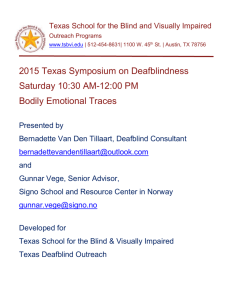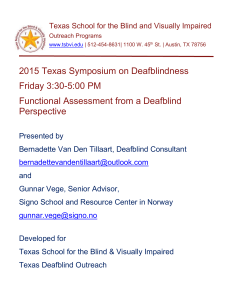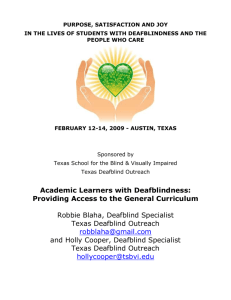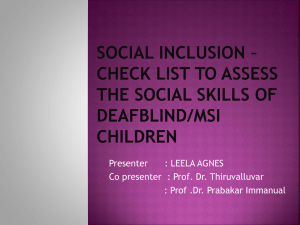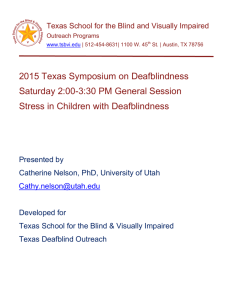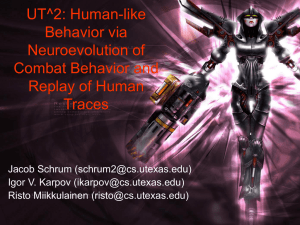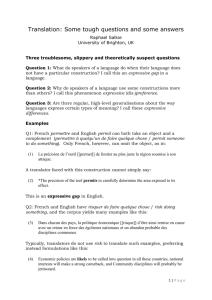Word - Texas School for the Blind and Visually Impaired
advertisement
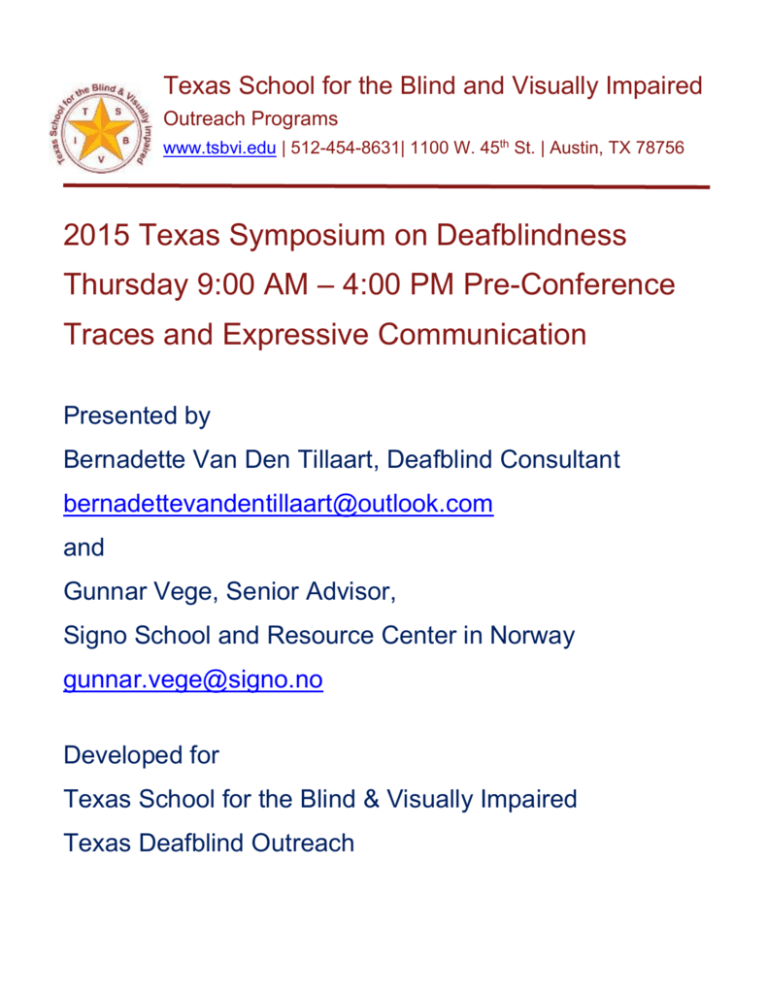
Texas School for the Blind and Visually Impaired Outreach Programs www.tsbvi.edu | 512-454-8631| 1100 W. 45th St. | Austin, TX 78756 2015 Texas Symposium on Deafblindness Thursday 9:00 AM – 4:00 PM Pre-Conference Traces and Expressive Communication Presented by Bernadette Van Den Tillaart, Deafblind Consultant bernadettevandentillaart@outlook.com and Gunnar Vege, Senior Advisor, Signo School and Resource Center in Norway gunnar.vege@signo.no Developed for Texas School for the Blind & Visually Impaired Texas Deafblind Outreach Traces and Expressive Communication Bernadette Van Den Tillaart and Gunnar Vege Summary In this pre-conference the presenters illustrate and discuss how impressions leave traces and create expressions for communication. They offer the participants an approach on how to create shared tactual experiences and memory traces, acknowledge and recognize the child’s utterances, and, build reciprocal and expressive symbolic communication. Experiences leave memory traces. Our body is active and present during the experience but will not remember every detail. It will remember though some moments that left a strong impression, such as a particular sensory observation, like a touch or sound; how which body part moved; comfort or hunger. These moments are always emotionally loaded. Therefore, the experience will also leave in that memory trace the emotion that was involved, be it frustration, joy or savoring. These are bodily emotional traces (BET’s). How can we create these moments of lived life together with a child with deafblindness, moments that leave significant and meaningful impressions? How can we be part of sustained shared experiences leaving impressions we find joyful to think about? These sharable moments can be found in the tactual world, perceived through sensations with and on the body and hands. The experience may unfold like a narrative with increasing and decreasing emotional waves. When we succeed in detecting what is sharable, follow the unfolding narrative and let this become part of our jointly experienced life moments, we may nourish an image of one self as an "I" whom experienced something together with "YOU". Traces are in the mind and they are not visible. Yet, being reminded of a previous experience the child with deafblindness may repeat what he remembered most strongly, a small movement or sound that carved a mental trace from that previous moment. The sounds and gestures that emerge from these memory traces give us something important to communicate about together. When the child initiates this utterance, how can we recognize what the child was thinking of? How should we respond to his expression? How can the communication partner acknowledge the utterance of the child? The communication partner who shared the tactile experience carries the same or similar memory traces himself, and therefore will be able to initiate communication about the experience in an interesting manner. The expressions of bodily emotional traces are the foundation for expressive communication development. As communication partners we need to be and remain interesting, for the child with deafblindness to be motivated to share experiences, to express what was remembered and to stay involved in a sustained here-and-now interaction filled with meaning. The approach discussed and illustrated in this pre-conference fosters thinking, provides new leading to a continuous growth and development for both the child and the communication partner. We will pose the question: how can we foster a 'SELF' who would wish and attain a more meaningfully lived life.... together with you? 2015 Texas Symposium on Deafblindness Pre-Conference – Traces and Expressive Communication – Van Den Tillaart, B. & Vege, G. 1 Story At the pre-conference, the presenters will show several video fragments. One of the video’s is about Ingerid. This is a story about Ingerid, her teacher and their process, from the documentary ‘Traces’ (Vege, Franzen Bjartvik, Nafstad et al., 2007). The film ‘Traces’ is a documentary of the communicative relation between a congenitally deafblind young woman and her teacher. They succeed in having a conversation about memories based on shared experiences, and the film displays the way they achieve this. The young woman, Ingerid, is completely deaf and blind. The communication with her builds on movement and touch, which is the only modality they have in common. The originally major difference between Ingerid’s deafblind way of being in this world and the teacher’s seeing and hearing way of being becomes reduced to an extent that the two may build up a communicative relation based on Ingerid’s world. Up to about 14 years old Ingerid had been exposed to simple tactile signs supported by tactile objects of reference when the teachers tried to communicate with her. At the time the topics for communication were the activities of daily life. The purpose was to help Ingerid feel more secure about, have more understanding of and to be able to make choices among these activities. However, many of the signs and the objects of reference seemed to make no sense to her. Maybe the activities were not meaningful to her either, or maybe it made not sense to her to talk about them. Since then, Ingerid’s teacher has tried to change his approach to communication in a such a way that it brings more focus to the signs which have their origin in traces from Ingerid’s bodily way of being in this world – through movement and touch. The film sheds light on the teacher’s search for those aspects of the event which may be clearly perceived by Ingerid, and which make enough impression on her to make her attentive to them and make them stick to her mind. When the teacher sees and feels that a certain impression takes root in Ingerid, he expresses to Ingerid that he stops at it and he bears in mind that she showed interest for precisely this aspect. The film shows how the teacher’s interest for what Ingerid is interested in is communicated to Ingerid, and vice versa. We see that Ingerid and the teacher both use their hands in ways corresponding to the way vision is commonly used among hearing and deaf persons in order to establish and maintain shared attention to an element in the external world. The fact that we establish and maintain shared attention towards an element in the external world is a fundamental prerequisite for being able to communicate about it; i.e. we stay with it so that it may be pointed at, be referred to and be commented on. A dominating topic throughout the film is the establishment of shared attention towards an element in the external world. We observe that the characteristics of the elements in the external world (a bookbag, an orange, a plate), to which they both are attentive to, change. We see that Ingerid at first notices a distinct aspect of a here=and-now event, e.g. a movement with a certain direction and a certain localization. Afterwards, this distinct movement may be recognized in the gesture which she presents. Because the teacher noticed how Ingerid produces her own gestures, he may anew give her the basis for doing so. A focal point in this approach is to pave the way for Ingerid to make her own gestures so that the two may have their conversations about her life-world. When both impressions and expressions are precisely based on what Ingerid experienced and how she experienced things, it is her natural expression that in cooperation with the teacher is given a form in the dialogue. Ingerid is given a proper voice. To have a proper voice here means that Ingerid may express her own perspective, her 2015 Texas Symposium on Deafblindness Pre-Conference – Traces and Expressive Communication – Van Den Tillaart, B. & Vege, G. 2 own position, her own orientation and her own conscience about the world seen from the perspective of a person with congenitally deafblindness. Ingerid’s congenitally deafblind way of being in this world would have been unintelligible for persons of a seeing and hearing culture if her particular way of being had not also been a variation over the fundamental and general human way of being. The bodily gestural expression is not a phenomenon specific to persons with congenital deafblindness. This statement is illustrated in the film by the sequence on communication with a hearing and seeing infant. The association with the infant does not indicate that the communication with children or young adults who are congenitally deafblind is that of an early step in development, but rather suggest that we deal with fundamental communicative processes which are shared among human beings, and which are displayed by the infant in the socially founded process of acquiring a culturally shared language. We see that the seeing and hearing infant Johanne in her conversation with her father is actively involved in trying to create a shared focus of attention and shared meaning in the communication which takes place here and now. However, the topic of the communication is beyond here and now. Little Johanne is influenced by her father’s invitation to manifest and share attention towards what is prominent in her mind –the broken arm of her grandfather- and more precisely the way he holds his arm. Little Johanne shows that what was important to her was exactly this: the unusual way the arm was tied and immobilized by the sling. Closing Comment In acquisition of language, typical conditions include sharing the focus of attention by exchanging expressions, such as body movements and gestures referring to a previous experience, that are emotionally loaded. This does not require competency of the language used in that culture. In the encounter with the infant it is more or less typical to express one’s self through movements and body language. For the communication partner, it does not feel very natural to use mainly movements and body language when encountering older children, youngsters and adults. Yet, the older child, youngster or adult with congenital deafblindness may express him or herself through body movements and gestures. The communication partner may not perceive these movements and touch as meaningful references, may not recognize that the person with deafblindness expresses thoughts about previous experiences, and therefore, may not recognize her or his potential to develop language. When this happens, the person with deafblindness may not have access to the necessary conditions for language development. 2015 Texas Symposium on Deafblindness Pre-Conference – Traces and Expressive Communication – Van Den Tillaart, B. & Vege, G. 3 Notes: 2015 Texas Symposium on Deafblindness Pre-Conference – Traces and Expressive Communication – Van Den Tillaart, B. & Vege, G. 4 2015 Texas Symposium on Deafblindness Pre-Conference – Traces and Expressive Communication – Van Den Tillaart, B. & Vege, G. 5 Texas School for the Blind & Visually Impaired Outreach Programs Figure 1 TSBVI logo. Figure 2 IDEAs that Work logo and OSEP disclaimer. 2015 Texas Symposium on Deafblindness Pre-Conference – Traces and Expressive Communication – Van Den Tillaart, B. & Vege, G. 6
